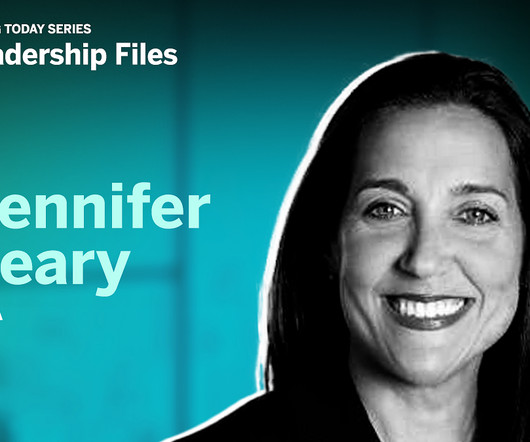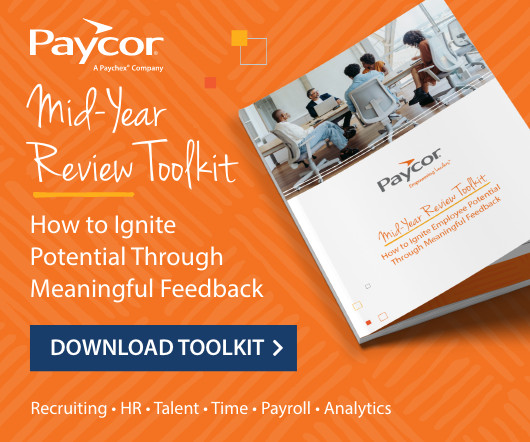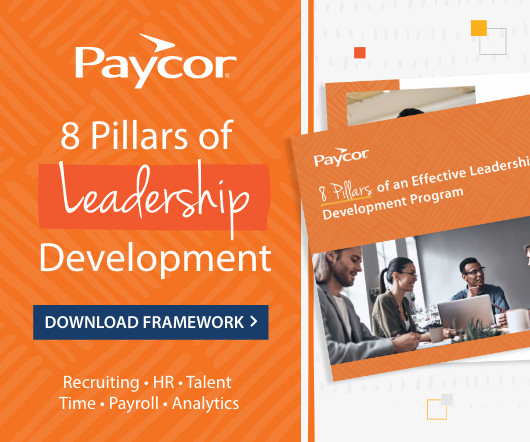The Leadership Files: Jennifer Leary
Accounting Today
OCTOBER 1, 2023
The chief of CLA shares the importance of empathy, authenticity and drive.

Accounting Today
OCTOBER 1, 2023
The chief of CLA shares the importance of empathy, authenticity and drive.

Xero
OCTOBER 1, 2023
Over the last 12 months, millions of customers around the world have been impacted by some of the biggest data breaches in history. As a small business or advisor working with sensitive personal and financial information every day, the stakes are high. If your business or practice experienced a data breach, it could have a serious impact on your livelihood.
This site is protected by reCAPTCHA and the Google Privacy Policy and Terms of Service apply.

CSI Accounting & Payroll
OCTOBER 1, 2023
Staying profitable in the transportation industry is a challenge these days, whether you're in freight or specialized trucking. Without a proper way to track and control operational expenses for your trucking company, you run the risk of going out of business. One way to gauge profitability is to calculate the cost per mile for each of your trucks. That way, you’ll have a better understanding of your expenses when it comes time to charge your customers.

Accounting Tools
OCTOBER 1, 2023
Related Courses Accountants’ Guidebook Bookkeeper Education Bundle Bookkeeping Guidebook What is a Nominal Account? A nominal account is one that is closed out at the end of each fiscal year. What is a Real Account? A real account carries forward its ending balance into the following year. Comparing Nominal Accounts and Real Accounts A nominal account starts the next fiscal year with a zero balance, while a real account starts with the ending balance from the prior period.

Advertiser: Paycor
Mid-year performance reviews aren’t just boxes for HR to check. Paycor’s toolkit empowers leaders to: Identify high-potential team members. Boost engagement with meaningful feedback. Support struggling employees. Nurture top talent to drive results. Learn how to ignite employee potential through meaningful feedback. When you nurture top talent, everybody wins.

IMA's Count Me
OCTOBER 1, 2023
In this episode, host Adam Larson sits down with Ashish Gupta , CFO North America at Reckitt, to explore the CFO's role in driving a sustainable earning model for businesses. Discover how Ashish's diverse leadership experience across continents has influenced his approach to sustainable growth and learn valuable insights on strategy, transformation, and execution.

AvidXchange
OCTOBER 1, 2023
HughesLeahyKarlovic (HLK) is a St. Louis-based creative and technology agency generating value for brands by connecting with audiences through powerful experiences. It focuses on creating brand experiences that accelerate behavior change by integrating into the lives of audiences, shaping their beliefs and producing excellent results. The Challenge HLK sought to automate its payments in anticipation of a large client onboarding that would triple its business.
Financial Ops World brings together the best financial operations content from the widest variety of thought leaders.

Accounting Tools
OCTOBER 1, 2023
Related Courses Working Capital Management There are several ways to improve the cash flows generated by the operations of a business. These methods are needed to keep from having to pay for expensive additional funding when cash requirements exceed the amount of cash on hand. 1. Collect Overdue Receivables Examine accounts receivable to see if there are any overdue invoices.

Accounting Tools
OCTOBER 1, 2023
Related Courses Accountants’ Guidebook The Balance Sheet What are Dividends? A corporation may issue dividends to its shareholders , which represent a distribution of its retained earnings to them. Dividends may be issued either in the form of cash or as additional shares of stock. In both cases, the amount paid out is in proportion to the number of shares already held by shareholders.

Accounting Tools
OCTOBER 1, 2023
Related Courses Cost Management Financial Analysis The break-even point of a business should be kept as low as possible, in order to keep the firm profitable even when sales decline. There are several ways to reduce the break-even point, as noted in the following points. Reduce Fixed Costs The typical company has many fixed costs , such as periodic rent payments, the salaries of administrative staff, and underutilized production equipment.

Accounting Tools
OCTOBER 1, 2023
Related Courses The Balance Sheet The Income Statement The Statement of Cash Flows What is a Consolidated Group? A consolidated group is comprised of a parent company and all of its subsidiaries. Consolidated financial statements are issued for a consolidated group. The group may also file a consolidated tax return with the Internal Revenue Service.

Speaker: Victor C. Barnes, CPA, MBA
In the climb from contributor to leader, the rules quietly change. But if you’re aiming for the summit, the air gets thinner, and what got you here won’t be enough to get you to the top. 🗻 What made you successful early in your finance career—technical accuracy, sharp analysis, flawless execution—won’t be what carries you to the next level. The higher you go, the more your effectiveness depends on how you connect, adapt, and communicate.

Accounting Tools
OCTOBER 1, 2023
Related Courses Accounting for Retirement Benefits What is a Contributory Plan? A contributory plan is a retirement plan that requires current employees or retirees to pay for a portion of the plan cost. Any amounts paid by employees are taken directly from their paychecks. Depending on the terms of the plan, these contributions may trigger increased benefit payments.

Accounting Tools
OCTOBER 1, 2023
Related Courses Accounting for Inventory Ending inventory is a key requirement when a business is closing its books. It is needed to derive the cost of goods sold , which in turn is needed to calculate profits. Thus, without an accurate ending inventory figure, it is impossible to determine a firm’s profitability. To calculate ending inventory, add all purchases during the period to beginning inventory , and then subtract the cost of goods sold.

Accounting Tools
OCTOBER 1, 2023
Related Courses Essentials of Marketing What is Cooperative Advertising? Cooperative advertising is a cost sharing arrangement to pay for advertising. Under this agreement, the manufacturer of goods agrees to compensate its distributors and retailers for a certain proportion of the advertising and promotion costs related to their sale of the manufacturer’s products.

Accounting Tools
OCTOBER 1, 2023
Related Courses Human Resources Guidebook What is an Inactive Employee? An inactive employee is an individual whose employment has not been terminated and yet is not currently rendering any services to the employer. This individual is expected to return to work. Examples of Inactive Employees For example, a person who is on disability leave, maternity leave, medical leave, jury duty, or military service leave would be considered an inactive employee.

Speaker: Kim Beynon, CPA, CGMA, PMP
The most overlooked, yet most critical, element of transformation is preparing people for change. Automation and AI aren't just technical upgrades, they’re cultural shifts which can challenge identities. That’s why change management isn’t a side project—it’s the foundation. In finance, where precision and process rule, navigating change can feel especially disruptive.

Accounting Tools
OCTOBER 1, 2023
Related Courses Accounting for Retirement Benefits What is Prior Service Cost? Prior service cost is the cost associated with additional benefits that have been granted via an amendment to a pension plan. This cost applies to employee services rendered in prior periods.

Accounting Tools
OCTOBER 1, 2023
Related Courses Corporate Finance Public Company Accounting and Finance Treasurer's Guidebook What is a Firm Commitment? A firm commitment is a promise to take a designated action within a specified period of time. The concept most commonly applies to a securities offering, where the underwriter commits to buy all unsold securities. Thus, the underwriter will purchase any remaining portion of the issuance that cannot be placed with investors.

Accounting Tools
OCTOBER 1, 2023
Related Courses Cost Accounting Fundamentals What is an Incurred Cost? An incurred cost is a cost arising from the consumption of an asset or service, or from a loss that has been sustained. Proper business planning requires management to have a detailed understanding of incurred costs in relation to revenues , in order to maintain an adequate level of profitability.

Accounting Tools
OCTOBER 1, 2023
Related Courses Accounting for Stock-Based Compensation What is an Explicit Service Period? An explicit service period is the amount of time stated in a share-based payment award that an employee must serve before the award will be paid out. For example, if an award document states that shares will vest after four years of continuous service, then four years is the explicit service period.

Speaker: Mark Gilham, FCCA, CPP
Finance used to be the function that counted, now it's the one that’s counted on. 📊 For accounting firms, controllers, and finance leaders, expectations are rising faster than headcount. Businesses want agile forecasts, granular analysis, seamless reporting, and smart automation—often without added resources while demanding uncompromised accuracy and compliance.

Accounting Tools
OCTOBER 1, 2023
Related Courses Effective Sales Management What are Direct Selling Costs? Direct selling costs include any expenditures made to secure a specific customer order. Examples of these costs are advertising targeted at new customers, sales commissions , travel to and from customer locations, and order processing costs. Direct selling costs do not include administrative expenses , facility costs, rent, or supervisory costs.

Accounting Tools
OCTOBER 1, 2023
Related Courses Corporate Finance Treasurer's Guidebook What is an Equity Restructuring? An equity restructuring is a transaction between a corporation and its shareholders that alters the fair value of the shares associated with an option or similar reward. Examples of the equity instruments that may be altered in a restructuring are a rights offering , stock split , or stock dividend.

Accounting Tools
OCTOBER 1, 2023
Related Courses Accounting for Stock-Based Compensation What is the Grant Date? A grant date is the date on which a stock option or other equity -based award is granted to the recipient. The grant date is considered to be that date on which an employer and an employee agree upon the most essential terms and conditions associated with the award. If shareholder approval is needed, then the grant date is considered to be delayed until that approval has been obtained, unless shareholder approval is

Accounting Tools
OCTOBER 1, 2023
Related Courses Accounting for Stock-Based Compensation Corporate Finance What is Restricted Stock? A restricted share is stock that cannot be sold, due to a limitation associated with that specific share. For example, an agreement between the issuer of stock and an investor may stipulate that the investor cannot sell the shares for a period of three years.

Advertiser: Paycor
Great leadership development is the key to sustainable business growth. Are you ready to design an effective program? HR can use Paycor’s framework to: Set achievable goals. Align employee and company needs. Support different learning styles. Empower the next generation of leaders. Invest in your company’s future with a strong leadership development program.

Accounting Tools
OCTOBER 1, 2023
Related Courses Bookkeeping Guidebook The Income Statement What are Sales Commissions? A sales commission is the amount of compensation paid to a person based on the amount of sales generated. This is typically a percentage of sales, which is paid on top of a base salary. Accounting for Sales Commissions Any commissions expense is recognized under the accrual basis of accounting as soon as the business has incurred the expense.

Accounting Tools
OCTOBER 1, 2023
Related Courses Corporate Cash Management Enterprise Risk Management Foreign Currency Accounting What is Foreign Exchange Risk? Foreign exchange risk is the possibility that the value of a transaction or an investment will change because of variations in currency exchange rates. For example, a seller commits to be paid in 60 days in a different currency ; if the value of that currency declines during the intervening time period, the seller will incur a loss when the receivable is paid.

Accounting Tools
OCTOBER 1, 2023
Related Courses Small Business Tax Guide What is Accelerated Depreciation? Accelerated depreciation is the depreciation of fixed assets at a faster rate early in their useful lives. This is done to recognize the increased usage experienced by some assets early on, as well as to reduce the amount of taxable income over the first few years of an asset’s useful life.
Let's personalize your content